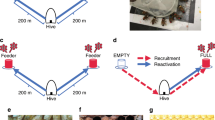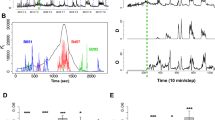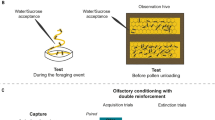Abstract
MORE than fifty years ago von Frisch demonstrated that foraging honey bees aroused the interest of potential recruits by means of a ‘dance’1. These experiments showed that the forager's body provides sufficient information about the odour of the food source to enable other bees to find that food in the field. In addition von Frisch demonstrated that foragers also leave odours at the food source which aid recruits in their searches1,2. Von Frisch later found that the dance also contains distance and direction information which the recruits seem able to use3,4.
This is a preview of subscription content, access via your institution
Access options
Subscribe to this journal
Receive 51 print issues and online access
$199.00 per year
only $3.90 per issue
Buy this article
- Purchase on Springer Link
- Instant access to full article PDF
Prices may be subject to local taxes which are calculated during checkout
Similar content being viewed by others
References
Frisch, K. v., Zool. Jb. (Physiol.), 40, 1–186 (1923).
Renner, M., Z. vergl. Physiol., 43, 411–468 (1960).
Frisch, K. v., Osterr. Zoolog. Zeitschr., 1, 1–48 (1946).
Frisch, K. v., Bull. Anim. Behav., 5, 1–32 (1947).
Wenner, A. M., Science, 155, 847–849 (1967).
Johnson, D. L., Science, 155, 844–847 (1967).
Wenner, A. M., and Johnson, D. L., Science, 158, 1076–1077 (1967).
Johnson, D. L., Anim. Behav., 15, 487–492 (1967).
Wenner, A. M., Wells, P. H., and Johnson, D. L., Science, 164, 84–86 (1969).
Wells, P. H., and Wenner, A. M., Physiol. Zool., 44, 191–209 (1971).
Frisch, K. v., Science, 158, 1072–1076 (1967).
Frisch, K. v., Anim. Behav., 16, 531–533 (1968).
Gould, J. L., Henerey, M., and MacLeod, M. C., Science, 169, 544–554 (1970).
Esch, H., and Bastian, J. A., Z. vergl. Physiol., 68, 175–181 (1970).
Lindauer, M., Am. Nat., 105, 89–96 (1971).
Mautz, D., Z. vergl. Physiol., 72, 197–220 (1971).
Wells, P. H., and Wenner, A. M., Nature, 241, 171–175 (1973).
Johnson, D. L., and Wenner, A. M., J. Apic. Res., 9, 13–18 (1970).
Frisch, K. v., Experientia, 18, 49–53 (1962).
Lindauer, M., and Schricker, B., Biol. Zbl., 82, 721–725 (1963).
Schricker, B., Z. vergl. Physiol., 49, 420–458 (1965).
Gary, N. E., and Witherell, P. C., Ann. Entom. Soc. Am., 64, 448–449 (1971).
Renner, M., Z. vergl. Physiol., 42, 449–483 (1959).
Free, J. B., Behaviour, 37, 269–285 (1970).
Author information
Authors and Affiliations
Rights and permissions
About this article
Cite this article
GOULD, J. Honey bee communication. Nature 252, 300–301 (1974). https://doi.org/10.1038/252300a0
Received:
Accepted:
Issue Date:
DOI: https://doi.org/10.1038/252300a0
This article is cited by
-
Teleosemantics and Pushmi-Pullyu Representations
Erkenntnis (2014)
-
Guidance by odors in honeybee navigation
Journal of Comparative Physiology A (2013)
-
Does Imprecision in The Waggle Dance Fit Patterns Predicted by The Tuned-Error Hypothesis?
Journal of Insect Behavior (2010)
-
Floral scents affect the distribution of hive bees around dancers
Behavioral Ecology and Sociobiology (2007)
-
The effects of season, pretraining, and scent on the efficiency of traps for capturing recruited honey bees (Hymenoptera: Apidae)
Journal of Insect Behavior (1996)
Comments
By submitting a comment you agree to abide by our Terms and Community Guidelines. If you find something abusive or that does not comply with our terms or guidelines please flag it as inappropriate.



